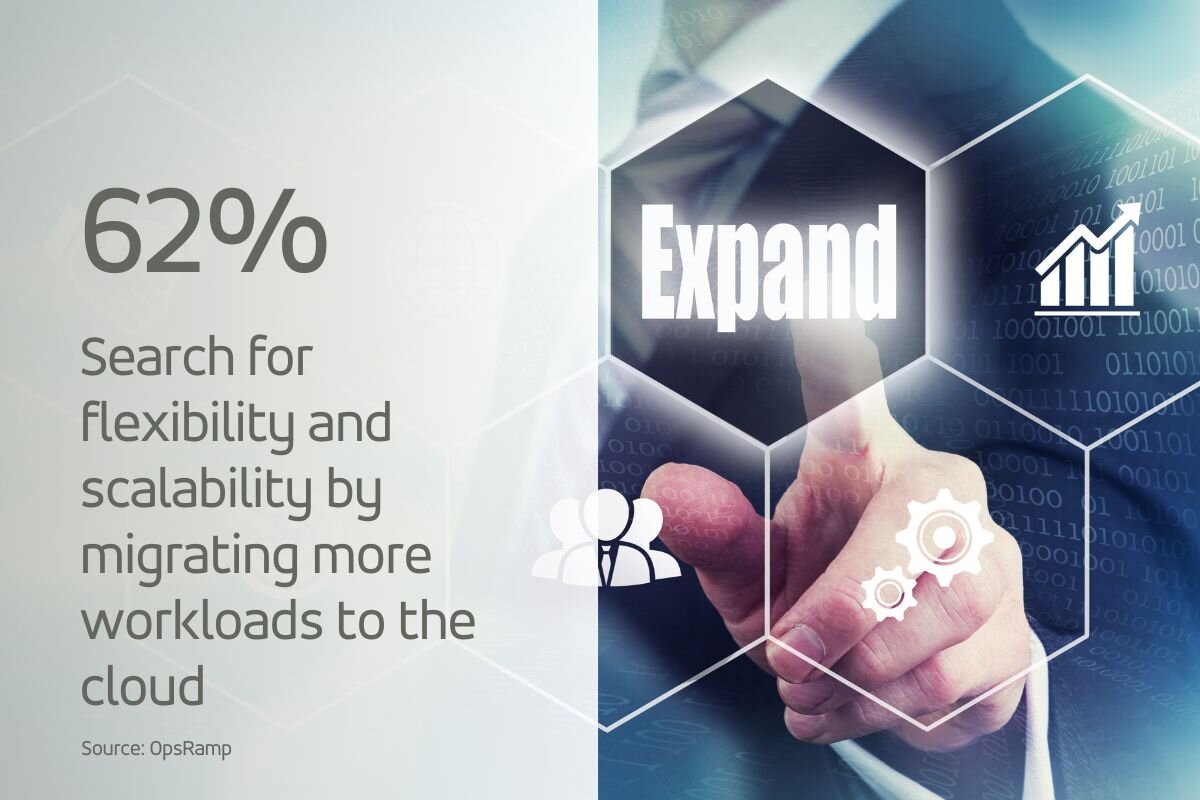Multi-cloud strategy part 2: Key considerations
03.10.2023
Using Multiple Public Cloud providers might be both tempting and challenging, but there are a few technical considerations we need to consider. As the digital landscape evolves, businesses are finding that no single cloud solution can meet all their needs. A multi-cloud strategy, which employs two or more cloud services, can offer the flexibility, resilience, and optimization that modern businesses demand.
In this part of our multi-cloud blog series, we explore the key considerations and unveil valuable insights and real-life cases that demonstrate how organizations can strategically implement and optimize their multi-cloud approach, resulting in enhanced cost-effectiveness, agility, and competitive advantage.
Multi-cloud key considerations
From managing costs and optimizing performance to ensuring data security and maintaining seamless integration, these considerations serve as a compass to guide businesses toward successful multi-cloud deployments. By understanding and addressing them, organizations can harness the true potential of multi-cloud environments while effectively mitigating potential challenges.
Navigating multi-cloud connectivity
Imagine wanting to seamlessly transfer files between an iPhone and an Android. While it's doable, anyone who's tried it knows it's not as simple as drag and drop. Similarly, when we attempt to connect multiple cloud platforms with our in-house systems, we're met with unique challenges.
Why? Think of cloud providers like these distinct phone ecosystems. Just as iPhones and Androids have different operating systems and protocols, cloud platforms like Azure and AWS are built differently. Here’s how we can bridge the two:
Unified networking:
Setting foundations: Large corporations typically utilize multiple cloud accounts or subscriptions. It's vital to establish a singular, coherent network within each cloud provider. Think of this as creating a unified address book for each phone. Without this, interconnecting them would be a mess. Indeed, if we just let every team set up their own VNET in Azure or VPC in AWS, we are going to face many challenges, some of which are impossible to solve without migrating a few applications.
Beware of overlaps: Just as two people cannot share a single phone number, we need unique subnet ranges between our cloud networks.
Streamlined communication:
Mastering cloud lingo: Cloud services rely heavily on DNS (Domain Name System) - it is like the contact list on a phone. While Azure and AWS each have their own 'contact lists,' we need a master one that combines both. Crafting this requires a special setup, but the good news is there is no overlap, making the integration smoother than anticipated. In addition, this process is not that hard as luckily different providers use different domains and there will be no overlapping.
Secure cross-talk:
Identity crisis: Just as an iPhone app cannot access an Android's in-built features directly, a service in AWS cannot simply borrow Azure's credentials. This means our communication lines, while secure, would require a bit more setup. Instead of automatic identification, we will need specific 'passwords' or keys.
Speed of exchange:
Keep it close: Imagine trying to have a fast-paced conversation where one person is in New York and the other in Tokyo. That is how latency works. Keeping our primary systems, say a backend server, in Azure while having our main database in AWS, can slow down our conversation. Even if they are geographically close, any delay can hamper performance.
Understanding your tech landscape
Just as iPhones and Androids are designed for varying functionalities, different cloud platforms shine in specific areas. Choosing the right platform for the right task ensures you are capitalizing on the strengths of each provider, rather than redundantly deploying multiple tools for identical tasks. Aim for platforms that promise ease of integration; this ensures a harmonious, smooth-running system.
Furthermore, akin to the effort required to make two different phones communicate efficiently, keep in mind the management overhead for each cloud service. This effort will influence both the cost and performance of your multi-cloud strategy.

Mastering user access in a multi-cloud landscape
Understanding the multi-platform access challenge:
Picture a scenario in which you are overseeing security for two major office complexes. Everyone, whether they are developers, managers, or accountants, requires their unique access badges tailored to their specific roles. Now, these are not ordinary office buildings; they are dynamic, rapidly evolving ecosystems – much like our cloud platforms, Azure, and AWS. Making sure every individual has the right badge, granting them access to specific rooms without causing overlaps or security breaches, can be a complex logistical puzzle. Furthermore, each cloud system offers its distinct set of permissions, akin to different room layouts and security protocols in the buildings. Trying to match one set with the other can be like trying to fit a square peg in a round hole.
The single access solution - AWS's SSO:
However, this matching of permissions can be somewhat easily solved at least on some scale. Picture AWS's Single Sign-On (SSO) service as a universal key card, a master key, if you will. This is not just a regular key card—it has the capability to seamlessly integrate with Azure's directory, acting as a bridge. By effectively integrating this SSO solution, we are streamlining our access system, making it less of a two-building conundrum and more of a unified complex. This not only simplifies management but also provides us with a holistic view of user access, ensuring we remain compliant. Additionally, having a unified system makes transitions smoother, be it onboarding a new employee, managing a contractor's temporary access, or offboarding a departing team member.
Accedia's End-to-end Azure Development Services
Governance in the cloud skyscrapers:
To foster seamless operation across multi-cloud environments, governance is the key. As in any modern skyscraper, where there are set protocols for visitor access, elevator usage, or emergency responses, our digital buildings also demand structured policies.
Enforce consistent protocols: Introduce uniform protocols for computing and networking across all cloud environments, ensuring effortless integration and compatibility.
Universal security rules: Implement similar tracking, alerting, and incident response mechanisms to maintain security across all cloud environments.
Map workloads efficiently: Like assigning the right office to the right department in a skyscraper, ensure workloads are mapped to the best infrastructure components and services based on specific business needs.
Strengthening the foundation with security and data protection:
As with any structure, the foundation's integrity is paramount. In our digital buildings (AWS and Azure), this foundation is data security.
IAM in place: Incorporate robust IAM practices, ensuring proper user provisioning, stringent access controls, and continuous access rights review across all cloud settings.
Adherence to data protection standards: Comply with relevant regulations, implementing data governance practices like data classification, encryption, and secure key management. Regular backups and disaster recovery plans are also essential to safeguard data and ensure business continuity.
Unified security platform: Instead of juggling various provider-specific tools, opt for a central security platform that offers a consolidated view and management solution for multi-cloud security. Align security strategies with necessary compliance standards like HIPAA and consider integrating DevSecOps principles throughout your development lifecycle.

Benefits of a unified access system:
A centralized access management approach offers more than just convenience. It becomes our single source of truth for monitoring and managing access levels for all users. This unified view ensures that transitions, whether it's the onboarding of a new team member, granting limited-time access to contractors, or the offboarding of a departing employee, are smooth, secure, and efficient. It also fortifies our defense against potential security breaches and unauthorized access. By having all our access-related data in one place, audits become more straightforward, ensuring we're always one step ahead in terms of compliance and security best practices.
Harnessing the power of tools like AWS's SSO and understanding the intricacies of access management across multi-cloud platforms can significantly elevate our operational efficiency, security, and compliance standards. It's about making the technology work for us, ensuring a smoother and more harmonious multi-cloud integration.
Strategizing application deployment in multi-cloud environments
Leveraging unique cloud offerings:
Multi-cloud environments are akin to shopping in a vast marketplace where each vendor specializes in unique products. The allure of using exclusive or higher quality services available from one provider is undeniable. However, this benefit comes with its complexities. Imagine trying to combine components from different vendors to make a singular product—there might be compatibility issues, delays in assembly (like latency), or challenges in sourcing specific components. An application drawing native services from multiple cloud vendors could find itself in a precarious position, akin to a machine needing all parts from different suppliers to function optimally.
Accedia Recognized as a Bulgarian's Finest Cloud Consulting Company
Ensuring application cohesion:
When crafting an application, it's wise to think of it as a finely-tuned instrument. Just as an instrument's components are designed to work harmoniously within a specific framework, an application should ideally reside within a single cloud provider. If our strategy positions each application as a distinct entity or component, these components can interact or be in different environments. However, fragmenting a single application's services across providers is like splitting an instrument's parts between various craftsmen—it's challenging to ensure harmony.
The "Cloud Agnostic Design" paradigm:
In the realm of architectural designs, a "Cloud Agnostic Design" stands out as the epitome of flexibility—it's like designing a product that can be manufactured seamlessly by multiple vendors. Such an approach ensures our applications remain nimble, with the capability to migrate across cloud providers. This strategy breaks free from the constraints of relying on a single provider—a huge advantage, especially if our operations hinge on uninterrupted service. Consider a media conglomerate as an example. In an industry where downtime translates to substantial revenue loss, having the ability to switch or integrate platforms can be invaluable. While the probability of an entire platform's failure is low, businesses always need to factor in every risk, no matter how minute. The potential financial implications of such a rare occurrence can be monumental.
Crafting an adept multi-cloud strategy is akin to orchestrating a grand symphony. Every choice, from application design to deployment, contributes to the overall harmony and success of our operations. By understanding the intricacies of each cloud provider and directing our ensemble with foresight, we can achieve a performance that resonates with success.
Implementing cost transparency
Based on our experience, CEOs and CFOs prioritize cost considerations when it comes to IT spending and assessing the value it delivers to the organization. To align with the financial goals of the business, it is crucial to start the cloud management journey by focusing on cost optimization. However, managing costs in a multi-cloud environment can be even more challenging due to the diverse billing methods employed by different service providers.
Experienced technology partners can provide a comprehensive suite of tools, consulting services, and expertise to assist organizations in understanding their cloud usage and associated costs throughout the company. This knowledge empowers them to negotiate better pricing with providers and standardize billing communication.

In case you want to handle it all by yourself, it is essential to implement a system that enables oversight of costs for every expenditure across all vendors that facilitates:
- Measurement of costs associated with the setup of each cloud platform
- Tracking of service usage and resource consumption
- Assessment of integration expenses and traffic costs
- Identification of unnecessary spending, such as unused instances, poor instance sizing, and inefficient resource allocation
- Forecasting of future expenses and identification of cost-reduction opportunities
- Providing spending patterns to aid in business planning and decision-making
Just like tracking workloads, employing a mapping strategy helps monitor deployments and relevant cost metrics. This information enables the evaluation of the value and profitability of each service investment.
Additionally, it is crucial to track the time and effort spent by your team on managing various cloud platforms. Measuring the cost of time spent working on each service provides insights into its profitability and allows for better resource allocation.
In the end
Navigating a multi-cloud environment demands thoughtful strategy and adaptability. While different cloud platforms bring unique strengths, the challenges lie in ensuring seamless access, robust security, and effective governance. By understanding our tech landscape and considering the intricacies of each platform, we can optimize our systems for performance, security, and cost-effectiveness. In a world increasingly reliant on diverse cloud solutions, it is this strategic approach that will empower businesses to thrive in an ever-evolving digital ecosystem.
Resources:
2023 State of the Cloud Report, Flexera
Cost of a Data Breach 2022, IBM
Shift to Cloud Report, Gartner
Five Trends Reveal the Emergence of Cloud-First Enterprises, OpsRamp